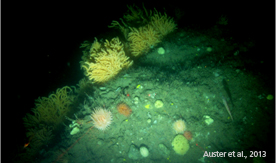Deep-Sea Dive Discoveries

A research team recommending that greater conservation measures be applied to two rare, dense coral garden communities that it discovered in the Gulf of Maine has three University of Maine connections.
Rhian Waller, associate research professor at UMaine’s Darling Marine Center in Walpole; Steven Auscavitch, master’s candidate in marine biology; and Les Watling, Professor Emeritus in the School of Marine Sciences and now a faculty member at the University of Hawaii at Manoa, were part of the team headed by Peter Auster of the University of Connecticut that found two deep-sea coral communities in July 2013 in the western Jordan Basin and Schoodic Ridge regions of the Gulf of Maine.
While deep-sea octocorals have been in the Gulf at least since the late 19th century when fishermen delivered them to museums as bycatch, researchers say bottom-scraping fishing gear has reduced their presence to small refuges. Due to the corals’ vulnerability and sensitivity to disturbance, the team advised that spatially explicit protection measures be applied to them.
“Discovering these lush coral gardens in the Gulf of Maine was an amazing experience this summer; some of the large coral trees we saw were over 2 meters high and have been growing in these protected pockets for an extremely long period of time,” Waller says. “These corals provide really important habitat for many of our local fisheries species, so finding areas where these corals have survived intense fishing pressure is a real boost to our understanding of habitat diversity and functioning in the Gulf of Maine.”
The team located the two deep-sea coral communities at depths greater than 200 meters. The topography was complex and areas with steep vertical rock faces had the highest densities of octocorals, say the researchers. The large-bodied corals extend up into the water and capture food with their hollow tentacles.
Pandalid shrimp were frequently found with the coral colonies, says the team. In addition, the team viewed Acadian redfish taking cover in the corals and saw Atlantic cod, cusk, pollock and silver hake catching prey among the octocorals.
Morgan Kilgour of UConn and David Packer of the National Oceanic and Atmospheric Administration (NOAA) also took part in the research. The team’s preliminary findings, “Octocoral gardens in the Gulf of Maine (NW Atlantic)” were published Oct. 16 in the online edition of Biodiversity.
Contact: Beth Staples, 207.581.3777
